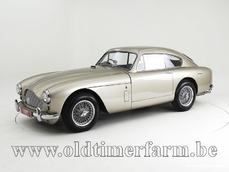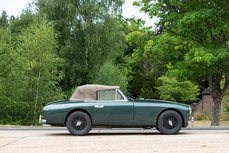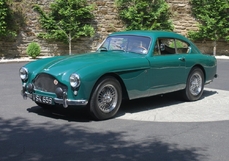Aston Martin DB2 1952
Allgemeine Beschreibung :
Virtually since the day Lionel Martin and Robert Bamford established Bamford & Martin in a South Kensington workshop, the company would experience wild swings of sporting success and brushes with financial ruin. Their Aston Martin cars (named in honor of Martin’s victory at the Aston Clinton Hillclimb) would prove to be very popular with wealthy sportsman, yet the business often struggled to stay afloat, and a string of investors, partners and owners each took turns running the firm through the 1940s. Under the leadership of A.C. Bertelli in the 1920s, Aston built upon its motorsports accomplishments and even enjoyed a brief period of financial security, but problems arose by the end of Bertelli’s tenure in 1937.
After World War II, Aston Martin was again put for sale with an ad placed in The Times advertising a “high-class motor business” for £30,000. Young industrialist David Brown answered the ad, and once in charge, he set about building Aston’s first post war sports car. Officially named the “Two Litre Sports”, but commonly known as the DB1, it wasn’t a huge success, but David Brown had a plan. He recently acquired the remains of Lagonda along with the services of W.O. Bentley and his design for a fabulous new 2.6 liter twin-cam six-cylinder engine. Brown saw this engine as the perfect fit for the first complete car built by Aston Martin under his leadership.
The new DB2 featured a slick new fully-enveloped aluminum alloy body designed by Frank Feeley, built atop a shortened and refined version of the tubular chassis from the DB1. Power was no longer an issue with Lagonda’s delectable 2.6 liter twin-cam inline six. The DB2 was a tremendous success for Aston Martin, with the works racing cars continuing Aston’s pre-war sporting accomplishments at LeMans, Spa and at home at the RAC Tourist Trophy. After several prototypes were built and successfully campaigned on track, road car production began in 1950, with the pretty fixed-head coupe (called the Saloon in factory literature) followed by an open drophead coupe shortly thereafter. 410 examples were built over the next three years before the DB2/4 replaced it. Aston’s DB2 has long been favored by collectors and driving enthusiasts for its beautiful looks, entertaining road manners, and W.O.’s sonorous inline six under the bonnet.
Presented in its handsome original livery of Post Office Red and with numbers-matching engine, this 1952 Aston Martin DB2 Saloon is a lovely example that is prime for enjoyment in countless events worldwide. Documentation shows LML/50/102 was originally delivered via Denver Imported Motors of Denver, Colorado, though the first owner’s name was not listed. Both the British Motor Industry Heritage Trust Certificate and factory service card show the car was delivered in Post Office Red over a red-piped black interior and that the car was uprated to Vantage spec prior to delivery. The second owner is noted on the service card as G.S. Toll, Esq. of Norwalk, California, although the history goes quiet from there. Eventually, the DB2 would make its way from the San Francisco Bay Area across the Pacific to Malaysia. It is presumed that once in Malaysia, it was converted to RHD to suit that country’s left-side traffic laws. In the early 2000s, LML/50/102 was acquired by a German living in Kuala Lumpur who subsequently treated the car to a comprehensive mechanical restoration centered on a full engine rebuild, the process of which has been well-documented through a large binder of receipts. Following its return to the USA, it joined an East Coast collection where recently it was extensively sorted and serviced to make it “on the button” and enormously entertaining to drive.
Today, this wonderful Aston DB2 presents in fine condition with tidy and attractive cosmetics that are consistent with its highly usable, event-ready nature. The good quality red paintwork has taken on a very slight patina since its restoration, yet it remains quite attractive overall. Panel fit is exemplary and the aluminum alloy factory coachwork is straight. The brightwork consists primarily of careworn but sound original pieces, with the exception of the bumpers which were recently refreshed. Wire wheels are painted silver/gray and feature original and correct Aston-branded knock offs. They wear recent 6.00-16 Michelin Pilote tires for the ideal period-correct look and performance.
The two-place cockpit is trimmed as original in black leather with red piping. It presents with a wonderfully inviting character that comes from moderate use, with supple leather and fine quality carpets and trim. The dash has been restored to a high standard, and is covered in red leather to complement the window trim and seat piping. The wood instrument fascia has been beautifully refinished and houses a complete array of original switchgear and dials. The original careworn Bluemels steering wheel was retained; full of character and corded for extra grip during spirited driving.
Since the original, matching-numbers 2.6 liter inline six was rebuilt in 2005, it has seen limited use and continues to run exceptionally well today. The presentation under the clamshell bonnet is very good with correct original carburetors and ancillaries in place. A full binder of receipts documents the complete engine rebuild, with the majority of the parts sourced via the classic experts at Aston Service Dorset. Since returning to the USA and while in the hands of the most recent owner, the suspension, brakes, rear axle, wiring looms and numerous other details were overhauled in 2016/2017. Receipts for parts alone exceed $20,000, and the result of all of that labor and expense is a car that performs exquisitely, with a tight and sorted chassis that inspires confidence and delivers a highly enjoyable drive. Presented in original colors and with its original engine, this meticulously maintained DB2 is eligible and ideally suited for numerous events worldwide, including the Mille Miglia, Le Mans Classic, and Tour Auto and is a fine choice for home-bound rallies such as the Colorado Grand or Copperstate 1000.
https://hymanltd.com/vehicles/6200
1952 Aston Martin DB2 is listed verkauft on ClassicDigest in St. Louis by Mark Hyman for $198500.
Fakten der Auto
Karosserietyp : Auto Marke : Aston Martin Modell : DB2 Hubraum : 0.0 Modelljahr : 1952 Lage : Missouri
Verkauft
Angaben Zum Verkäufer
Verkauft
People who viewed this Aston Martin DB2 also viewed similar Aston Martin listed at ClassicDigest
Other cars listed for sale by this dealer
über Aston Martin DB2
Der Aston Martin DB2 ist ein bedeutendes Modell in der Geschichte von Aston Martin und spielte eine entscheidende Rolle bei der Etablierung der Marke als führender Hersteller von Luxussportwagen. Hier ist ein Überblick über seine Geschichte, Spezifikationen, Produktionszahlen und Wettbewerbsgeschichte:1. Geschichte: Der Aston Martin DB2 wurde 1950 als Nachfolger des Aston Martin 2-Litre Sports eingeführt. Es war der erste Aston Martin, der von dem firmenintern entwickelten Motor angetrieben wurde. Der DB2 verfügte über eine schlanke und aerodynamische Karosserie, die von Frank Feeley entworfen wurde.
2. Spezifikationen:
- Motor: Der DB2 war ursprünglich mit einem 2,6-Liter-Reihensechszylindermotor ausgestattet, der als „W.O. Bentley“-Motor bekannt ist. Spätere Versionen, darunter der DB2/4 und der DB2/4 MkII, waren mit einem größeren 2,9-Liter-Motor ausgestattet.
- Leistung: Die Leistung variierte je nach Version, lag jedoch im Allgemeinen zwischen etwa 105 und 140 PS.
- Getriebe: Der DB2 wurde mit einem 4-Gang-Schaltgetriebe angeboten, und einige spätere Modelle verfügten optional über ein 3-Gang-Automatikgetriebe.
3. Produktionszahlen: Aston Martin produzierte den DB2 in verschiedenen Iterationen von 1950 bis 1953. Die genauen Produktionszahlen für jede Variante sind wie folgt:
- Aston Martin DB2: Ungefähr 411 Einheiten produziert.
- Aston Martin DB2/4: Ungefähr 565 Einheiten produziert.
- Aston Martin DB2/4 MkII: Ungefähr 199 Einheiten produziert.
4. Wettbewerbsgeschichte: Der Aston Martin DB2 erzielte bemerkenswerte Erfolge im Motorsport und trug zum Ruf von Aston Martin als Hersteller wettbewerbsfähiger Sportwagen bei. Zu den wichtigsten Wettbewerbshighlights gehören:
- 24 Stunden von Le Mans 1950: Der Aston Martin DB2 belegte in der 3,0-Liter-Klasse die Plätze 1 und 2 und markierte damit Aston Martins ersten Gesamtsieg in Le Mans.
- 24 Stunden von Spa 1951: DB2 gewann das Rennen in der 3,0-Liter-Klasse.
- Rallye Monte Carlo 1952: Aston Martin DB2 errang einen Klassensieg.
- Mille Miglia 1953: Aston Martin DB2 belegte den 1. und 2. Platz in der 3,0-Liter-Klasse.
Der Erfolg des DB2 und seine Rennerfolge legten den Grundstein für nachfolgende Aston Martin-Modelle und festigten den Ruf der Marke als Hersteller von Hochleistungssportwagen.
Insgesamt ist der Aston Martin DB2 ein wichtiges Modell in der Geschichte von Aston Martin, das den Übergang zur hauseigenen Motorenproduktion darstellt und die Präsenz der Marke auf dem Luxussportwagenmarkt festigt. Seine Kombination aus elegantem Design, Leistung und Erfolg im Motorsport trägt dazu bei, dass es heute bei Sammlern und Automobilliebhabern begehrt ist.











